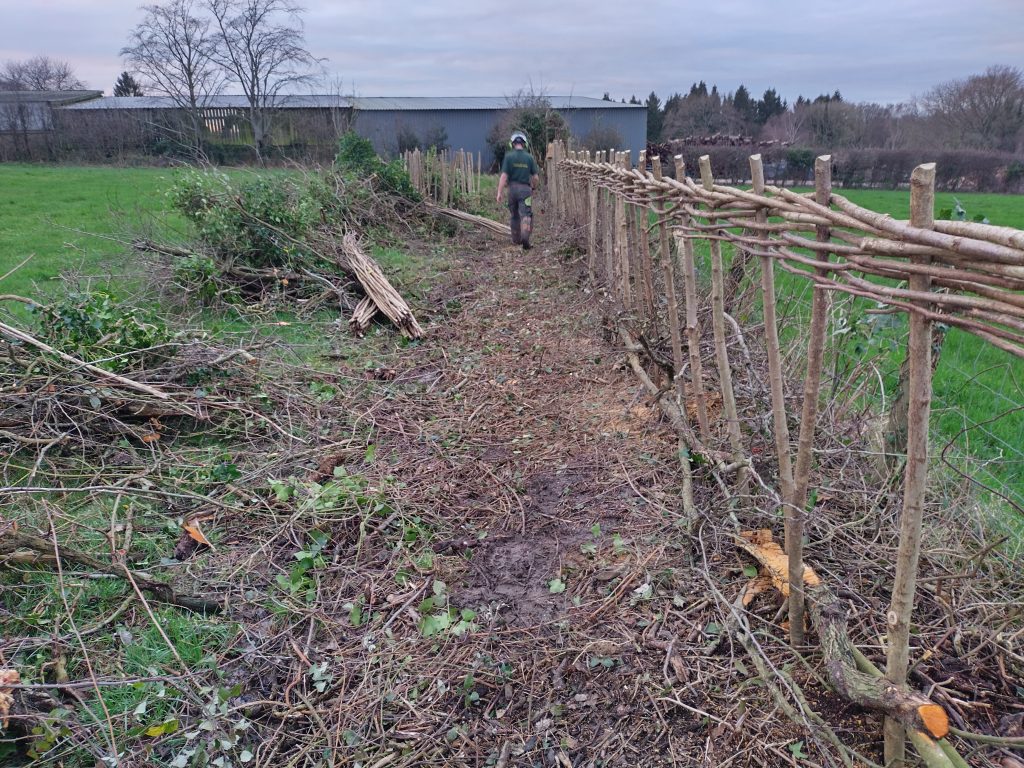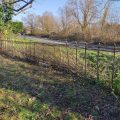
Having kicked my Lymphoma into touch, I was keen to get back to work as soon as I felt up to it. I had been warned that it could take several months before I felt like my old self again, and I was aware that my energy levels were still depleted. However, I had enlisted my good friend Benjamin Jennings to give me a hand on the next hedgelaying job which we began in mid-December 2023.
The hedge itself was over in east Hampshire near Droxford. 142 metres long, it was long overdue suitable management. It was chock-full of ivy, and many of the stems were starting to decline due to being shaded out and suppressed. Many more stems were actually dead within the hedge, with only the ivy actually holding them up. Another few years and it would have been beyond saving.
It was clear that there was going to be a lot of hard work involved in laying this hedge, a fact that was reinforced by the adjacent grass field being on clay and totally sodden through rain. Materials therefore had to be carried to the hedge along with all our tools!
The first section of hedge was also swamped with bramble on the neighbour’s side, as well as a couple of field gates and the obligatory barbed wire. However, we wasted no time in getting stuck in and soon had the first few metres down.
This is where I was so grateful to have Benjamin’s help on this hedge, especially during my recovery. He is half my age, and his energy levels seem to know no boundaries. He just threw himself into all the challenges that the hedge presented us with, not least the huge tangle of brambles!
By the end of the third day we had made good progress and the laid hedge was starting to take shape.
Several days later we had just about got halfway along the hedge and had passed the end of the bramble thicket. You can see the flattened bramble on the left in the above photo. On the right is the brash pile which clearly shows the amount of ivy in the hedge.
After the halfway point we said goodbye to the bramble thicket and hello to lots of gnarly and brittle hawthorn stems which are notoriously difficult to pleach and keep on their respective stumps. There was also plenty of dead wood in the hedge as well.
Even as we approached the end there was no respite. The last 10 metres was literally draped in ivy, all of which had to be cleared.
Eventually we reached the finish line. Whilst there were few pleached stems left in the hedge itself, we had cleared all the ivy and the dead wood and there were plenty of live stumps from which new shoots (coppice) will sprout, thus rejuvenating the hedge for the future.
It was a tough, but rewarding hedge to do knowing that we had saved a virtually derelict hedgerow. A few more years of neglect and there would have been no option but to coppice the whole thing to ground level and plant up the gaps. I am eternally grateful to Benjamin for his help on this hedge; without him I would have struggled to get the job done and it really brought home to me just how depleted my reserves were after the cancer treatment.
I have subsequently heard from the landowners during this past year and they are delighted with the amount of regrowth on the hedge. They have also planted up the gaps with new hedge plants and are looking forward to a new lease of life for the hedgerow.














